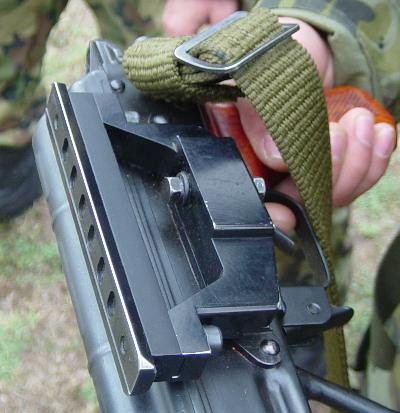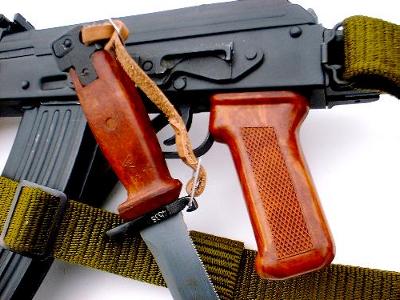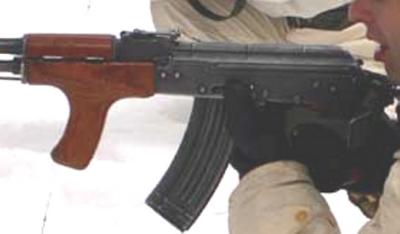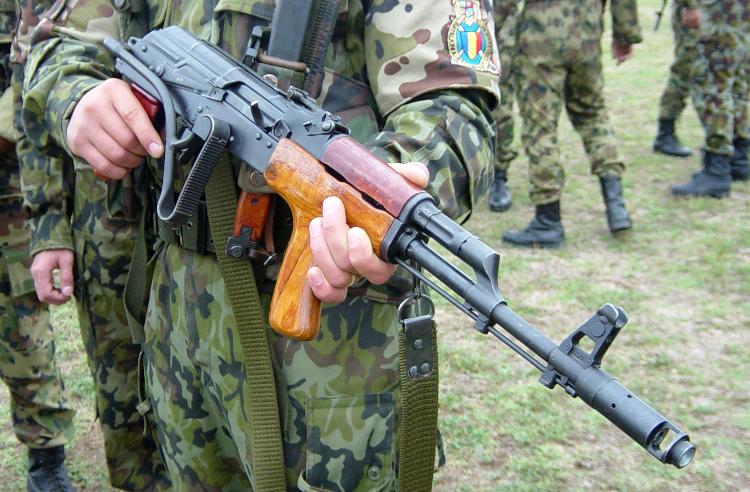
Romanian AIMS-74 calibru 5,45mm
PA Mitraliera Md. 86 {Pusca Automata model 1986)
RATMIL State Arsenals
S.Hood, B.Barnett, Jr., Romanian MOD, C.Hazell, Tantal
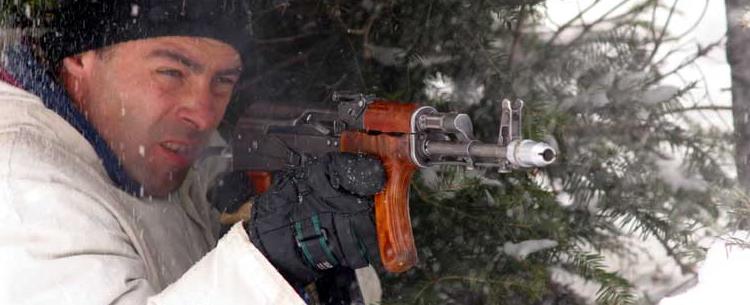
Training exercises with Romanian mountain troops. Image provided by The Romanian Ministry of Defense. Warfare in this type of environment is crucial to Romanian readiness, since much of the country is covered in similar terrain. History has shown that the ability of the army to operate in this environment can be a major factor.
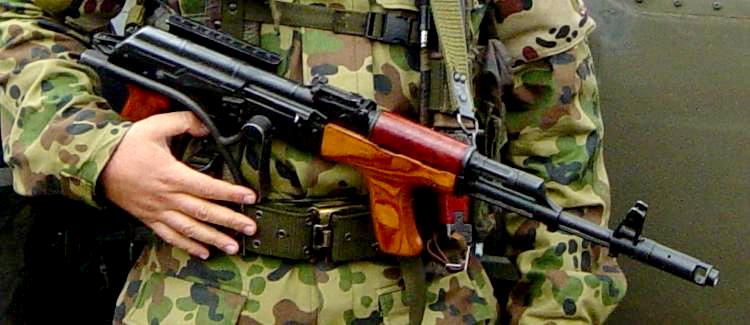
Although the Bucharest-based arms group Romtechnica is usually credited with the design of the AIMS-74, it appears that after the major reorganization of the Romanian arms industry after the revolution, all or part of production was transferred via the Romanian military conglomerate RATMIL (Regie Autonoma pentru productia de Tehnica Militara) to the Uzinie Mecanice Cugir plant in the Transylvanian Alps.
Romanian AK-74's in training with Romanian anti-terrorist personnel. The example in the foreground is outfitted with the Romanian 40mm under-barrel grenade launcher AG-40. Image provided by The Romanian Ministry of Defense.
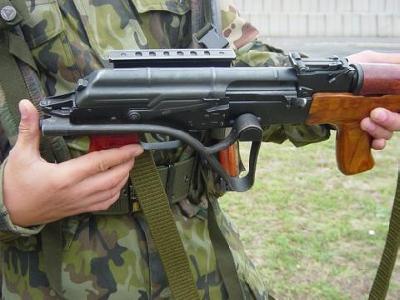
|
Many of the images seen here have been provided by our contributor in Kosovo, S. Hood. In fact, this page was motivated by (and heavily relies on) his contributions. Along with the excellent top image on this page, they detail an AIMS-74 in the hands of Romanian troops operating near Camp Bond steel in Bond steel as part of KFOR. We are very fortunate to be able to use them on the web site.
This particular rifle has the left side mounted optics rail, in addition to an unknown scope mount attachment. The Romanian standard issue AK-74 optics plate is a modified copy of the Soviet design for the second pattern AK-74, but it has been changed to fit the rivet pattern of the AKM rear trunnion. The side bracket/scope mount with top mounted dovetail (shown here) is finished in black and appears to be partially or completely made from aluminum. The mounting rail is directly over the mounting base, without offset to center. It is unfortunate that there is no optical device mounted. The rifle is equipped with the Romanian nylon type rifle sling, with black finished metal hardware. This finish is quickly worn off in the field. There are at least two types/colors of the nylon type straps used on Romanian web gear items used with the AK-74. One is an early bright gold color while the later type is a darker green. These nylon straps can be found on carrying cases, slings, bayonet attachments, and magazine pouches. Earlier rifles (i.e. AKM's) used bakelite materials of dark brown, dark red-brown, or even a light wheat color. Most plastic material found on the newer AK-74 are of a dark red-orange, or bright orange. The upper hand guard of the military issue AIM-74 is also made from a matching bakelite material, unlike previous rifles. This material is also used on the bayonet handles and pistol grips. Speaking of pistol grips, the Romanian variant of the Russian AK-style pistol grip has inverted checkering, meaning it does not have tall points but rather they are indented inward. This is one feature seldom seen in other pistol grips and a good way to tell if a particular pistol grip might be Romanian. Although almost every Romanian semi-automatic AK-74 rifle imported into the US has the optics mounting rail, it is appearing that many (if not a majority) of the Romanian domestic military rifles do not have them. Note the AK-74 image at bottom left. This rifle is being used by a Romanian mountain troop, and obviously has no left side optics plate. This is common among almost all of the rifles we have found images of in service with Romanian mountain troops. This should not be that surprising since optics are scarce and hardly ever observed, and in practical regards the optics mounting rail has always been mainly for use with night vision devices on this type of rifle. Most likely, US importers who have brought in the Romanian AK-74 in some numbers specifically required the optics rail on those semi-automatic rifle. As far as AKM features, this rifle has more retrograde elements than other currently produced AK-74 types, no doubt in an effort to cut costs of converting portions of the design which would not greatly effect performance. One of primary importance to project builders is the larger trunnion barrel socket diameter (23mm versus 22mm). This means AK-74 barrels from other countries are too small to properly press into the Romanian trunnion block. |
The most easily recognized AKM feature is the gas block design (45 degree versus 90 degree). Incidently, although the gas block is purely AKM, the gas vent in the barrel did change to a 90 degree design to minimize bullet shearing (a problem with early Soviet AK-74's with 45 degree gas blocks). This means the Romanian AK-74 has a double angle gas port, making it much harder to clean the gas vent!
True Russian AK-74 features include the calibre with accompanying feed grooves, "trigger bumps," long head bolt with thin stem, muzzle brake, front sight base with threaded extension and a second bayonet lug, and the ability to use any Russian AK-74 magazine.
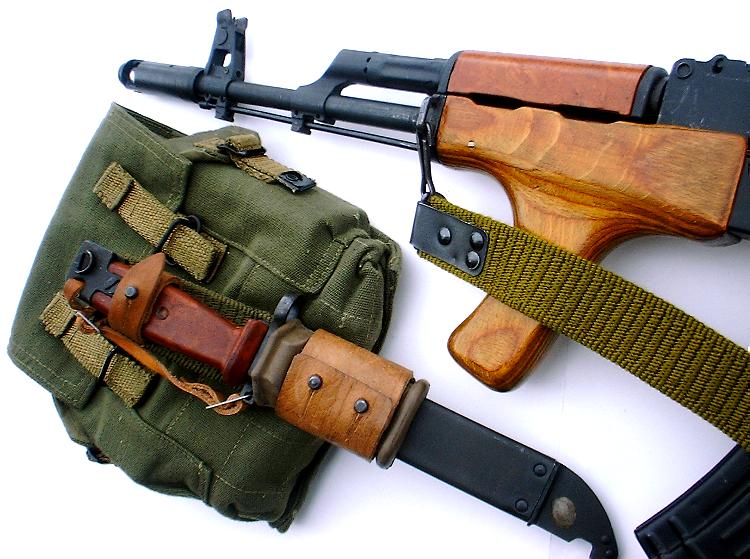
Detail of barrel assembly with AKM style gas block, dual bayonet lugs, military style vertical fore grip lower hand guard, bakelite upper hand guard, 4-cell magazine pouch with dual pull tabs, and special bayonet.
This means the Romanian AK-74 front sight base is also unique in several ways. As noted previously, it has a 21mm threaded extension for the muzzle brake, and secondly, the bayonet lug has been moved to a position below the sight tower, rather than on an extension behind it (in Soviet fashion). The bayonet is not the regular Romanian AKM pattern, but a copy of the Soviet 2nd pattern AKM/AK-74 with square handle. This was necessary, as the earlier model would not clear the bottom contours of the muzzle brake and front sight base. More information on the bayonet can be found on ourRomanian AK-74 bayonet page.
The metal finish on Romanian army AK-74 rifles is a medium or dark phosphate, without the Russian style black paint over phosphated metal. This finish is thin and known to wear easily. Selector markings are not normally painted white as in some other models.
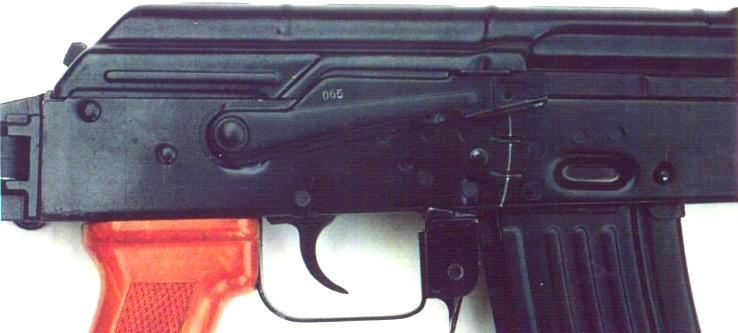
Right hand side of receiver. This rifle was an early export variant and has what appears to be a black painted finish, rather than the Romanian military bare phosphating. We have never seen painted Romanian AK-74's in the hands of Romanian military personnel. This rifle was also fitted with a standard "export" type smooth lower handguard of Russian AKM design.
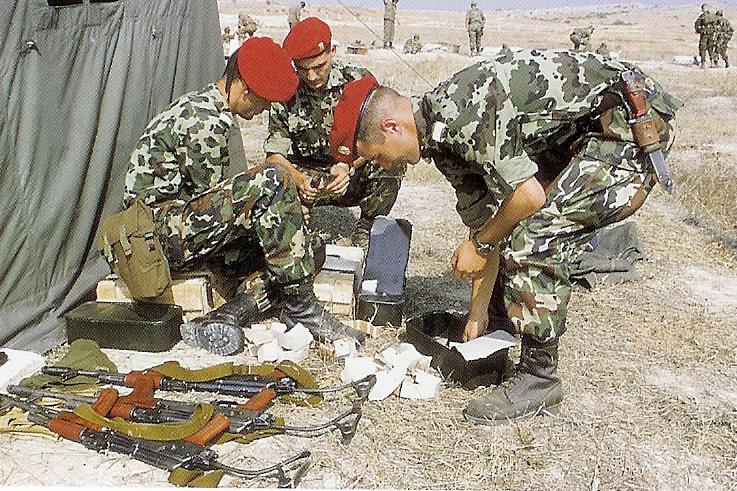
These Romanian troops are reloading ammunition somewhere in Afghanistan. This image provides an excellent view of specific equipment and AIMS-74 accessories. Note the specific square handled bayonet and the four cell magazine pouch used with the AIMS-74.
The domestically produced 30-round box magazine is made from ribbed metal, and there is no record of any other type of material being used in their production. There is also a 40-round version, no doubt used with the Romanian RPK-74 variant. Note the bright reddish-orange color of the plastic used on Romanian AK-74 rifles, which seems much lighter and brighter than those normally used on the previous 7,62x39mm rifles.
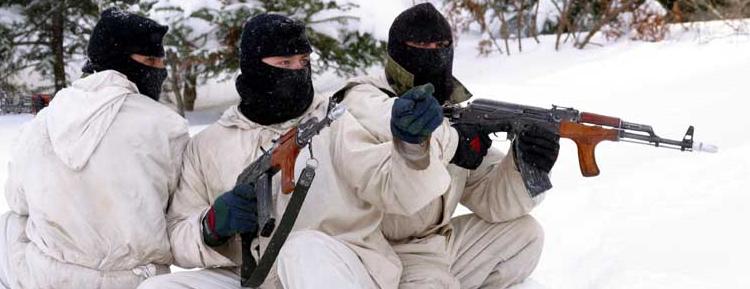
Mountain troops field AIMS-74 rifles during a winter exercise. Image provided by The Romanian Ministry of Defense.
We wish to thank everyone who made this page possible. In the future, we hope to add to the materials shown here, in an effort to capture the full story on this very interesting small arm design. Please feel free to contact us and offer your comments or any images or information you may like to share.

